Located in the heart of Washington’s Olympic Peninsula, Olympic National Park offers an unmatched diversity of landscapes that few places in the world can rival. This UNESCO World Heritage site is home to lush temperate rainforests, dramatic alpine ridges, glacier-capped mountains, and more than 70 miles of wild Pacific coastline—all within one park.
This unique blend of ecosystems makes the Olympic a top-tier hiking destination in the Pacific Northwest. Whether you’re looking for a peaceful walk through ancient forests, a thrilling coastal trek, or a strenuous climb with panoramic mountain views, the park delivers.
In this guide, we’ll explore the best hikes in Olympic National Park—ranging from easy family-friendly strolls to more adventurous and scenic routes. You’ll discover what makes each trail special, how long it takes, and what you’ll see along the way.
What Makes Olympic National Park Special for Hikers?
What sets Olympic apart is its incredible biodiversity and range of ecosystems. You can wander through the moss-draped trees of the Hoh Rain Forest in the morning, climb an alpine ridge at Hurricane Ridge by midday, and walk along tide pools on a rugged beach by sunset.
The park offers trails for all levels of hikers, from flat nature loops to steep climbs with serious elevation gain. Whether you’re a beginner or a seasoned trekker, you’ll find hikes that suit your pace and preference.
Olympic National Park is also open year-round, though seasonal variations play a big role in trail access. Summer and early fall are ideal for most hiking, offering clearer skies and snow-free paths. However, winter snowshoeing at Hurricane Ridge and foggy rainforest walks also provide unforgettable experiences in the colder months.
10 Best Hikes in Olympic National Park
Olympic National Park is a hiker’s paradise, offering an incredible mix of rugged coastlines, lush rainforests, and alpine peaks—all within one protected landscape. Whether you’re new to hiking or an experienced trekker, the park has trails suited to every level. In this guide, we’ve rounded up the 10 best hikes in Olympic National Park, categorized by difficulty, to help you plan the perfect outdoor adventure.
- Hikes 1–4: Easy trails ideal for beginners, families, and relaxed explorers.
- Hikes 5–7: Moderate hikes that offer stunning scenery with a bit more challenge.
- Hikes 8–10: Strenuous routes for those seeking high-elevation views and wilderness solitude.
Lace up your boots—these are the trails you won’t want to miss.
Read More: Best Sedona Hiking Trails Easy
1. Hoh Rain Forest Trail (Hall of Mosses)
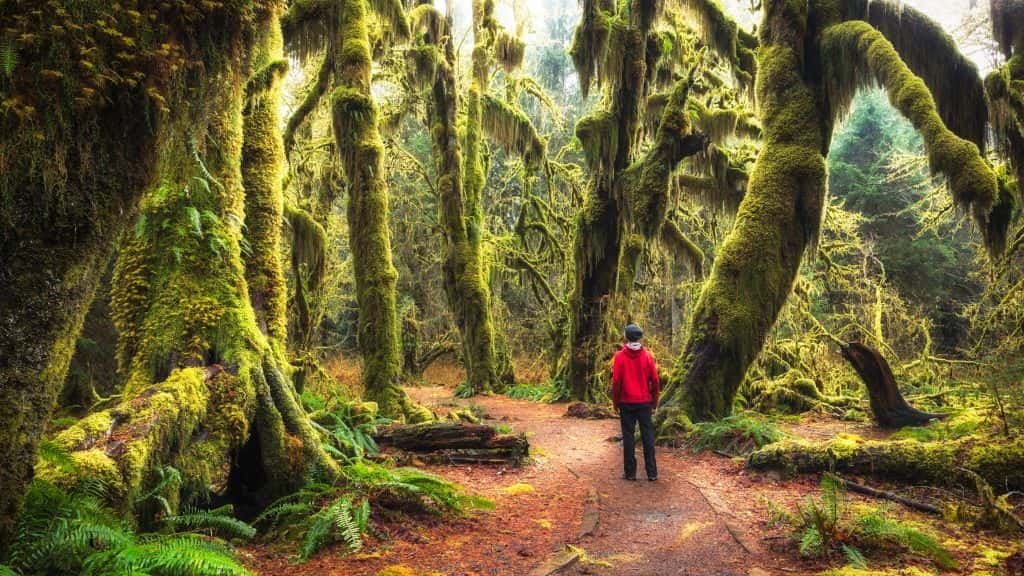
- Distance: 0.8 miles loop
- Elevation Gain: ~100 feet
- Estimated Time: 30–45 minutes
The Hall of Mosses Trail is one of the park’s most iconic hikes. This short loop takes you deep into the heart of the Hoh Rain Forest, where massive Sitka spruce and bigleaf maples are draped in hanging moss. It’s an otherworldly experience—like stepping into a fantasy world. Look out for Roosevelt elk and a variety of birdlife along the way. This trail is perfect for all ages and offers a great introduction to the park’s lush interior.
2. Marymere Falls Trail
- Distance: 1.8 miles round trip
- Elevation Gain: ~400 feet
- Estimated Time: 1 hour
Starting near the beautiful Lake Crescent, the Marymere Falls Trail is a scenic and well-maintained path that leads to a stunning 90-foot waterfall. The trail winds through old-growth forest and crosses charming wooden bridges before gently climbing to a viewing platform. It’s a great option for families and those who want a taste of Olympic’s forested beauty without a major time commitment.
3. Rialto Beach to Hole-in-the-Wall
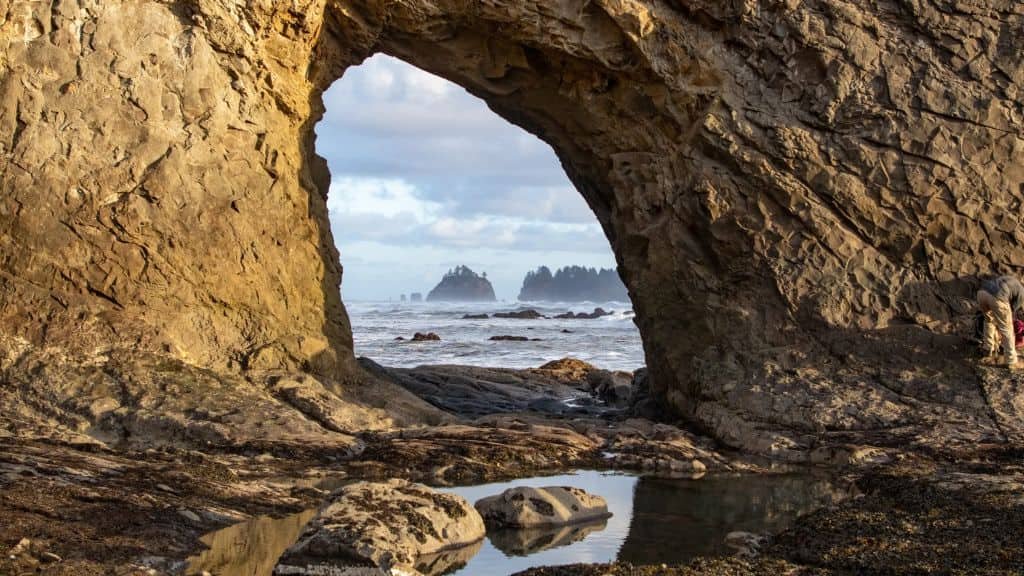
- Distance: 3.3 miles round trip
- Elevation Gain: Minimal
- Estimated Time: 1.5–2 hours
This coastal hike is both dramatic and peaceful. Starting at Rialto Beach, the trail follows the Pacific Ocean north to a stunning rock formation known as Hole-in-the-Wall, where erosion has carved a natural arch into the sea stacks. Along the way, hikers can explore tide pools, watch for sea birds, and enjoy incredible views of driftwood-strewn beaches and sea stacks. Check the tide chart before you go—the trail is best (and safest) at low tide.
4. Spruce Nature Trail
- Distance: 1.2 miles loop
- Elevation Gain: Minimal
- Estimated Time: 30–45 minutes
Located in the Hoh Rain Forest area near the Hall of Mosses, the Spruce Nature Trail offers a peaceful and educational walk through some of the park’s most iconic landscapes. The loop passes through lush rainforest, along the banks of the Hoh River, and past towering spruce and hemlock trees. Interpretive signs along the trail provide insight into the ecosystem, making it a great option for families and first-time visitors. The flat terrain and wide path make it one of the most accessible trails in the park.
Read More: Trails Carolina Death List
5. Sol Duc Falls Trail
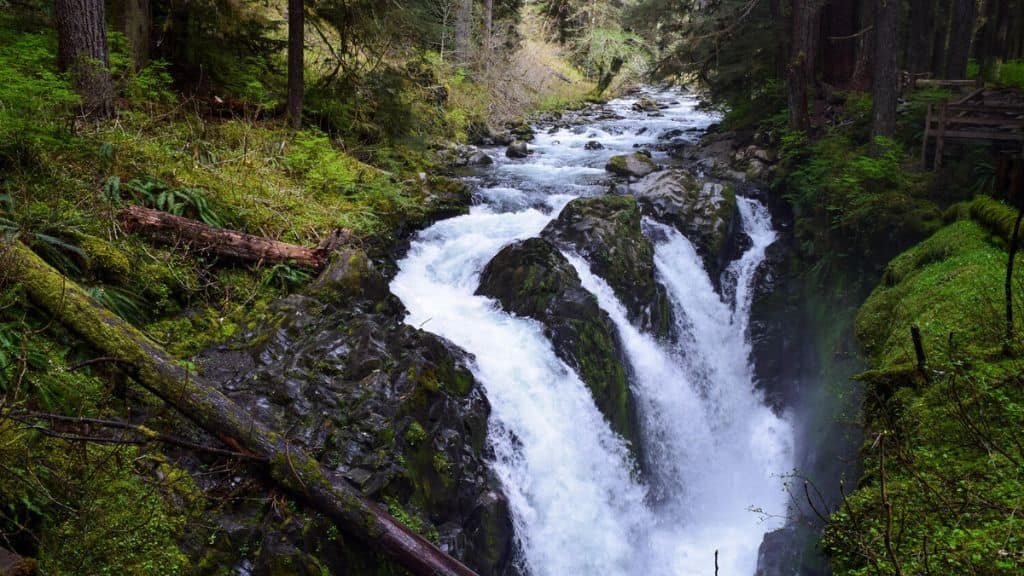
- Distance: 1.6 miles round trip
- Elevation Gain: ~200 feet
- Estimated Time: 45–60 minutes
This forested trail is an excellent choice for hikers looking to immerse themselves in Olympic’s old-growth scenery without committing to a long trek. The path winds through mossy trees and over footbridges before reaching the spectacular Sol Duc Falls, which split into three streams as they thunder into a narrow gorge. Located near the Sol Duc Hot Springs Resort, this hike is a perfect combo of natural beauty and post-hike relaxation.
6. Second Beach Trail
- Distance: 1.4 miles round trip
- Elevation Gain: ~280 feet
- Estimated Time: 1 hour
This short yet stunning trail through coastal forest leads to Second Beach, a pristine stretch of coastline framed by sea stacks and driftwood. As you descend to the beach, the views open up to a breathtaking seascape perfect for photography, tidepooling, or simply watching the waves crash. It’s a great sunset hike, but be sure to bring a headlamp if you’re staying late.
7. Lake Crescent – Mount Storm King (to the lookout)
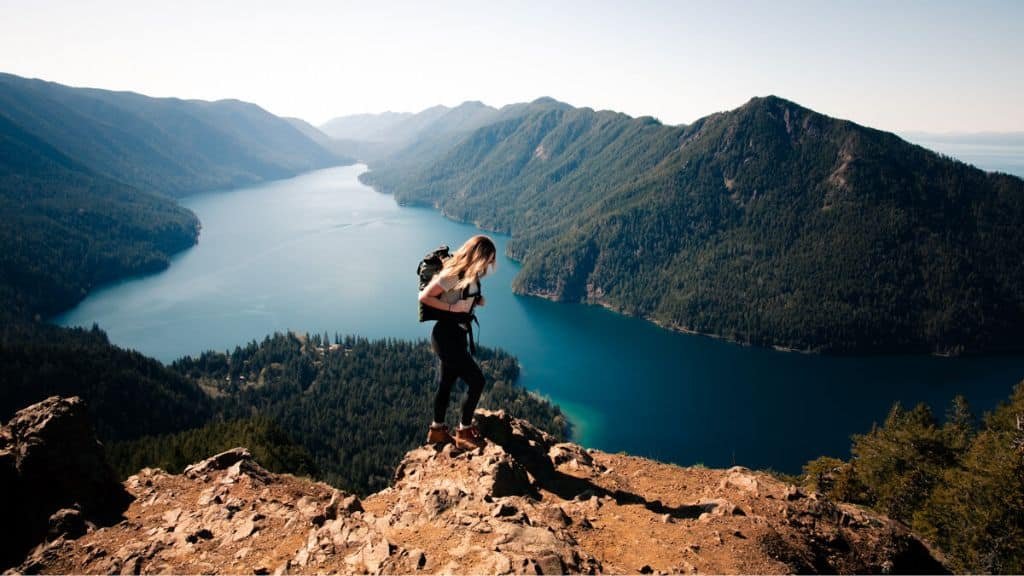
- Distance: 4 miles round trip (to rope section/lookout)
- Elevation Gain: ~2,000 feet
- Estimated Time: 3–4 hours
Mount Storm King is a challenging but doable hike for those with moderate fitness. The trail begins at Lake Crescent and climbs steeply through dense forest. While the official trail ends before the summit, many hikers stop at the rope-assisted scramble section, which leads to a rocky lookout point offering jaw-dropping views of the lake and surrounding peaks. It’s steep, but the payoff is unforgettable.
8. Mount Ellinor Trail
- Distance: 3.2 miles round trip (from upper trailhead)
- Elevation Gain: ~2,300 feet
- Estimated Time: 3–4 hours
For experienced hikers looking for a workout and a panoramic reward, Mount Ellinor delivers. The trail gains elevation quickly and offers incredible views of Mount Rainier, Puget Sound, and the Olympic Mountains. On clear days, you might even spot goats, marmots, and eagles. The lower trailhead adds a few miles if you’re up for a longer challenge. Early summer snow and ice may require traction devices.
Read Also: Exploring Rugged Trails
9. Hurricane Hill via Hurricane Ridge
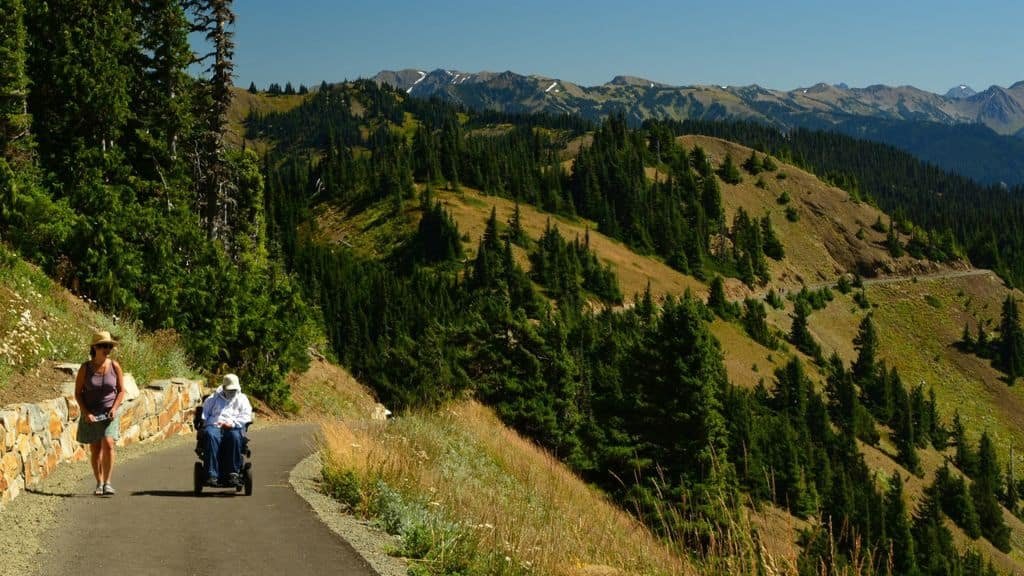
- Distance: 3.2 miles round trip
- Elevation Gain: ~650 feet
- Estimated Time: 1.5–2 hours
Starting from the Hurricane Ridge Visitor Center, this paved trail leads to an exposed ridge with 360-degree alpine views. While not long, the elevation and exposure to wind can make this trail feel more intense. In summer, you’ll find blooming wildflowers and a good chance of wildlife sightings. In winter, the trail is popular for snowshoeing, but seasonal road closures may limit access—check conditions ahead of time.
10. Seven Lakes Basin / High Divide Loop
- Distance: ~19 miles loop
- Elevation Gain: ~4,000 feet
- Estimated Time: 2–3 days
This is a backpacking classic in Olympic National Park. The loop begins at the Sol Duc Trailhead and takes you through dense forest, past waterfalls, into alpine basins filled with sparkling lakes, and along the breathtaking High Divide ridge. Expect incredible views of Mount Olympus, possible bear and deer sightings, and stunning campsites. A wilderness permit is required, and the trail is usually snow-free from mid-July through September.
Unique Hiking Experiences
One of the best parts of hikes in Olympic National Park is the variety of environments you can explore in a single trip. Beyond the typical trails, the park offers some uniquely immersive experiences you won’t want to miss.
Beach Hiking & Tide Pooling
Ruby Beach and Third Beach offer stunning coastal hikes with dramatic sea stacks, driftwood-covered shores, and vibrant tide pools teeming with marine life like starfish, anemones, and crabs. These hikes are especially magical during low tide, when you can safely explore the tide pools and walk beneath massive rock arches. Just be sure to check the tide charts in advance, as some areas can become dangerous during high tide.
Rainforest Exploration
For an off-the-beaten-path rainforest experience, the Bogachiel River Trail is a hidden gem. Located in the quieter western side of the park, this trail leads you deep into the temperate rainforest along the banks of the Bogachiel River. With fewer crowds than the Hoh, this trail offers a tranquil setting for those seeking solitude among moss-draped trees and fern-covered floors.
Snowshoeing or Winter Hikes
When snow blankets the mountains, Hurricane Ridge becomes a winter wonderland. It’s one of the few areas of the park regularly plowed and open in winter, making it ideal for snowshoeing and winter hiking. You’ll enjoy sweeping snowy vistas, frosty evergreens, and crisp alpine air. Be prepared for changing conditions, and check park alerts before heading out.
Also Read: A Trail of Smiles
Best Times to Hike in Olympic National Park
Olympic National Park is open year-round, but the best time to hike depends on what kind of experience you’re after.
Summer (June–September)
This is the most popular season, offering clear trails, warm weather, and full access to alpine hikes like Mount Ellinor and Seven Lakes Basin. Wildflowers bloom in July and August, and the longer daylight hours give you more time on the trail. However, popular spots can be busy, so start hikes early to avoid crowds.
Fall (October–November)
Fall brings cooler temperatures and colorful foliage, especially in the forested trails around Sol Duc and Hoh Rain Forest. It’s a quieter time in the park, making it great for solitude. Some higher elevation trails may start seeing snow by late October.
Winter (December–February)
High elevation areas like Hurricane Ridge offer snowshoeing and limited winter hikes, but trail access is dependent on road conditions. Coastal hikes and rainforest trails remain open, making this a unique time to experience misty beaches and quiet forests—just bring rain gear and prepare for muddy trails.
Spring (March–May)
Snow begins to melt, and lowland trails open up again. Waterfalls are at their most powerful, and new growth appears in the rainforests. Alpine trails may still be snow-covered, but spring is perfect for lower-elevation hikes.
Safety Tips and Trail Etiquette
Hiking in Olympic National Park is a rewarding experience, but it’s important to stay safe and respect the environment.
Trail Conditions and Wildlife Safety
Always check trail conditions with a ranger station or the National Park website before heading out. Be aware that some trails may be affected by fallen trees, snow, or flooding. Wildlife like bears, elk, and mountain goats are common in the park—keep a safe distance, store food properly, and never feed animals.
Leave No Trace Principles
Olympic’s beauty relies on all of us doing our part. Stay on marked trails, pack out all trash, and leave natural objects undisturbed. Avoid stepping on fragile vegetation and don’t stack rocks or carve into trees.
Tide Schedules for Beach Hikes
Timing is critical when exploring the coastal trails. Rialto Beach, Ruby Beach, and others may become inaccessible or dangerous during high tide. Check the NOAA tide schedule for Kalaloch or La Push before you go, and plan accordingly to avoid getting stranded or trapped by rising waters.
You can Read: Are Blundstones Good for Hiking?
Final Thoughts
Hikes in Olympic National Park offer something for everyone. From mossy rainforests and thunderous waterfalls to alpine ridgelines and rugged coastlines, the park’s diverse landscapes create unforgettable trail experiences for all types of adventurers.
Whether you’re strolling through the Hoh Rain Forest, watching the sun set from Second Beach, or climbing toward the High Divide, each trail reveals a unique side of the park’s magic. The key to enjoying these hikes is preparation, flexibility, and respect for nature.
Plan ahead, pack smart, stay safe—and let the breathtaking hikes in Olympic National Park inspire your next outdoor journey.


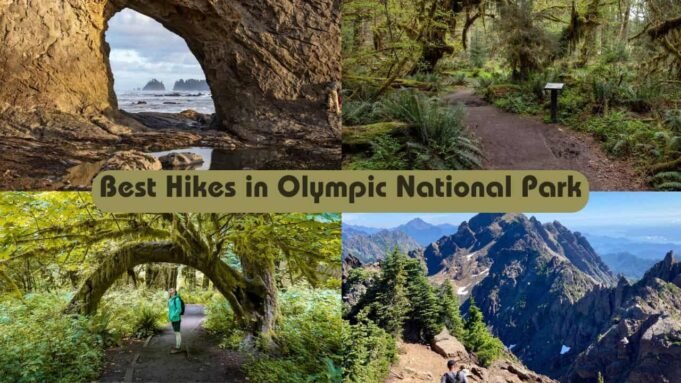













[…] Read More: 10 Best Hikes in Olympic National Park […]
[…] of tranquility and dramatic scenery. Tucked away in Southeast Iceland near the edge of Vatnajökull National Park, this hidden canyon rewards hikers with steep, moss-covered cliffs, glacial rivers snaking through […]
[…] trip to Gatlinburg is complete without experiencing the Great Smoky Mountains National Park. Even with just a morning to spare, you can enjoy its natural beauty. There are many […]
Comments are closed.